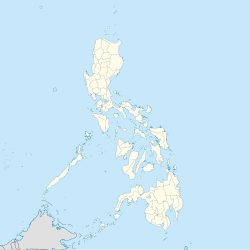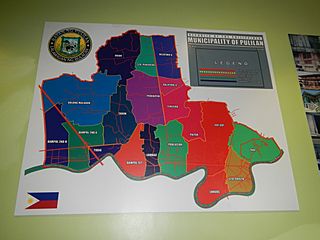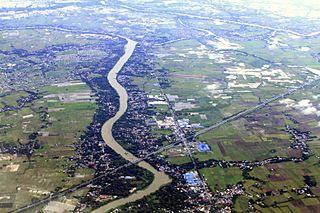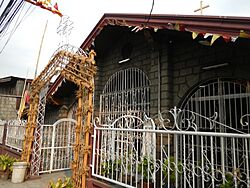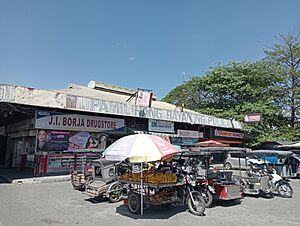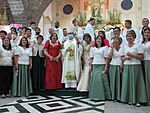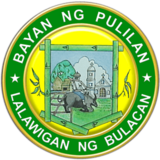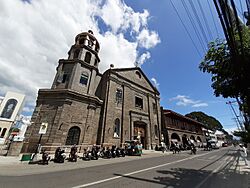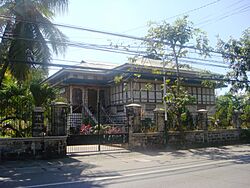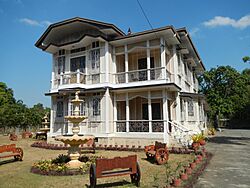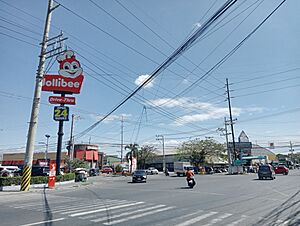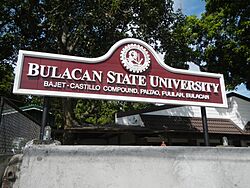Pulilan facts for kids
Quick facts for kids
Pulilan
|
|||
|---|---|---|---|
| Municipality of Pulilan | |||
|
From top, left to right: Ancestral house in Pulilan; San Isidro Labrador Parish Church; Pulilan–Calumpit Road; and church decorations at the annual Carabao festival
|
|||
|
|||
Nickname(s):
|
|||
| Motto(s):
Celebrate Pulilan Power!
|
|||
| Anthem: Ako ang Pulileño English: (I am a Pulileño) |
|||
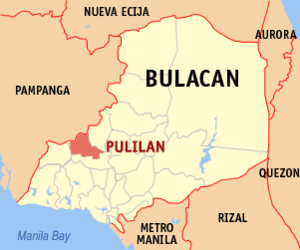
Map of Bulacan with Pulilan highlighted
|
|||
|
OpenStreetMap
|
|||
| Country | Philippines | ||
| Region | Central Luzon | ||
| Province | Bulacan | ||
| District | [[{{#property:P7938}} | — Lua error in Module:Wd at line 1804: attempt to index field 'wikibase' (a nil value).]] | ||
| Founded | January 20, 1796 | ||
| Barangays | 19 (see Barangays) | ||
| Government
|
|||
| • Type | Sangguniang Bayan | ||
| Area | |||
| • Total | 39.89 km2 (15.40 sq mi) | ||
| Elevation | 14 m (46 ft) | ||
| Highest elevation | 42 m (138 ft) | ||
| Lowest elevation | 1 m (3 ft) | ||
| Population
(2020 census)
|
|||
| • Total | 108,836 | ||
| • Density | 2,728.4/km2 (7,066.5/sq mi) | ||
| • Households | 28,066 | ||
| Demonym(s) | Pulileño (male) Pulileña (female) |
||
| Economy | |||
| • Income class | 1st municipal income class | ||
| • Poverty incidence |
|
||
| • Revenue | ₱ 678.9 million (2022) | ||
| • Assets | ₱ 940.2 million (2022) | ||
| • Expenditure | ₱ 526.8 million (2022) | ||
| • Liabilities | ₱ 306.8 million (2022) | ||
| Utilities | |||
| • Electricity | Meralco | ||
| Time zone | UTC+8 (PST) | ||
| ZIP code |
3005
|
||
| PSGC |
[https://psa.gov.ph/classification/psgc/?q=psgc/barangays/{{#pro000®code={{&provcode=
|
||
| IDD : area code | +63 (0)44 | ||
| Native languages | Tagalog Kapampangan |
||
| Website | www |
||
Pulilan is a busy municipality in the province of Bulacan, Philippines. It is officially known as the Municipality of Pulilan. In 2020, about 108,836 people lived there.
The town is famous for its special carabao festival. During this event, carabaos are paraded and even kneel as they pass by the San Isidro Labrador Parish Church. This is done to honor the town's patron saint, San Isidro Labrador.
Years ago, Pulilan was mostly a quiet farming town in northern Bulacan. Its economy relied heavily on farming and raising poultry. Most people earned their living from agriculture. Today, Pulilan is growing into a center for business and industry. It has become one of the fastest-growing areas in the province.
This growth is due to many new businesses, real estate projects, factories, and road improvements. Pulilan's income has increased a lot in recent years. For example, in 2016, the town's income was P323.86 million. This was a big jump from its income in 2014. Pulilan's income even became higher than some other towns in Bulacan, like San Miguel and Calumpit.
Pulilan is also part of the larger Manila's built-up area. This means it's connected to the big city, even reaching San Ildefonso, Bulacan to the north.
Contents
What's in a Name?
Pulilan was not always called Pulilan, and it wasn't always a town. Long ago, it was a marshy or swampy area. It was part of Pampanga, near the Candaba Bay.
In 1794, some missionaries named the place San Isidro. They did this to honor San Isidro Labrador, who is the patron saint of farmers. On January 20, 1796, the name changed to Pulilan. No one knows for sure how the name Pulilan came about. But a popular story says it came from Pulo ng Ilan. This means "clusters of small communities" or "islands."
A scholar named Antoon Postma studied an old document called the Laguna Copperplate Inscription. This document was found near Laguna Lake and dates back to 900 A.D. It mentions a place called Puliran. Mr. Postma believes this Puliran is actually the Pulilan in Bulacan, located along the Angat River, north of Manila.
A Look Back: Pulilan's History
We don't know exactly when people first settled in Pulilan. But based on records from nearby towns like Calumpit and Baliuag, we can guess that some settlers arrived in the early 1600s. The ancient town of Pulilan was first mentioned as "Puliran" in the Laguna Copperplate Inscription. This is the oldest known document from the Philippines, written in 900 A.D. At that time, the people were led by Lord Ka-Sumuran.
During the Spanish rule, an Augustinian friar named Fray Vicente Villamanzaro officially declared Pulilan a town on January 20, 1796. He chose San Isidro Labrador as its patron saint. The town's first leader was called a Kapitan. In 1819, Francisco Paltao became Pulilan's first Kapitan. Later, in 1898, Froilan Cahiwat became the first Presidente Municipal (Municipal President).
In 1904, Pulilan became part of a nearby town called Quingua (now Plaridel). But in 1909, some leaders from Pulilan asked Governor Teodoro Sandico to make Pulilan a separate town again. Their request was granted. Eugenio Tiangco then became the first Presidente of the newly independent Pulilan. After World War II, in 1946, Catalino Flores was appointed as the first Mayor of Pulilan.

Through Spanish, American, and Japanese times, many people from Pulilan fought for freedom. After gaining independence, the people of Pulilan worked hard to build their town. They made great progress in politics, economy, and social life. The people of Pulilan, known as Pulileños, value their rich history.
The town's patron saint, San Isidro Labrador, is celebrated every May 14. On this day, Pulileños parade carabaos, cows, and horses. The carabaos even kneel in front of the church to show respect to their patron saint. The parade also includes street dancers, marching bands, and colorful floats from local businesses.
Where is Pulilan?
Location and Landscape
Pulilan is one of Bulacan province's 21 towns. It is located near the center of the province. It is about 43 kilometers (27 miles) northwest of Manila, the capital of the Philippines. It is also 20 kilometers (12 miles) from Malolos, the provincial capital, and just 2 kilometers (1.2 miles) from Plaridel.
Pulilan covers an area of about 4,073 hectares (40.73 square kilometers). It shares borders with Apalit in Pampanga to the north, Baliwag to the east, Plaridel to the south, and Calumpit to the west. The Angat River flows along the eastern side of Baliwag and the southern part of Pulilan. It forms the boundary with Plaridel.
The land in Pulilan is mostly flat. Eleven of its barangays (villages) are located along the Angat River. The rest of the land is flat, irrigated rice fields. The soil types range from sandy loam to clay loam. This makes the area good for growing many different kinds of crops.
Most barangays in Pulilan are not very prone to flooding. However, some areas near creeks that flow into the Angat River, and low-lying barangays like Dulong Malabon and Inaon, are more likely to experience floods.
Land Use and Climate
Most of Pulilan's land is used for farming. About 27.92 square kilometers (10.78 sq mi), or 68.55% of the town's area, is used for growing crops. The remaining 12.8076 square kilometers (4.95 sq mi), or 31.45%, is used for homes, businesses, factories, and public buildings.
Pulilan has a tropical climate, according to the Köppen climate classification system. This means it gets a lot of rain for most of the year, with only a short dry season. The average temperature is about 27.2 °C (81.0 °F). The driest month is February, with very little rain. July usually has the most rain. May is the warmest month, averaging 29.2 °C (84.6 °F), while January is the coolest, at 25.5 °C (77.9 °F).
| Climate data for Pulilan, Bulacan | |||||||||||||
|---|---|---|---|---|---|---|---|---|---|---|---|---|---|
| Month | Jan | Feb | Mar | Apr | May | Jun | Jul | Aug | Sep | Oct | Nov | Dec | Year |
| Mean daily maximum °C (°F) | 28 (82) |
29 (84) |
31 (88) |
33 (91) |
32 (90) |
31 (88) |
30 (86) |
29 (84) |
29 (84) |
30 (86) |
30 (86) |
28 (82) |
30 (86) |
| Mean daily minimum °C (°F) | 20 (68) |
20 (68) |
21 (70) |
22 (72) |
24 (75) |
24 (75) |
24 (75) |
24 (75) |
24 (75) |
23 (73) |
22 (72) |
21 (70) |
22 (72) |
| Average precipitation mm (inches) | 6 (0.2) |
4 (0.2) |
6 (0.2) |
17 (0.7) |
82 (3.2) |
122 (4.8) |
151 (5.9) |
123 (4.8) |
124 (4.9) |
99 (3.9) |
37 (1.5) |
21 (0.8) |
792 (31.1) |
| Average rainy days | 3.3 | 2.5 | 11.7 | 6.6 | 17.7 | 22.2 | 25.2 | 23.7 | 23.2 | 17.9 | 9.2 | 5.2 | 168.4 |
| Source: Meteoblue | |||||||||||||
Barangays: Pulilan's Villages
Pulilan is divided into 19 smaller areas called barangays. Each barangay has its own smaller sections called puroks and some have sitios.
Dulong Malabon is the largest barangay in terms of land area. Poblacion is the most populated barangay, while Santa Peregrina has the fewest people.
| PSGC | Barangay | Population | ±% p.a. | |||
|---|---|---|---|---|---|---|
| 2010 | ||||||
| 031418001 | Balatong A | Expression error: Missing operand for /.% | 1,877 | 1,553 | 1.22% | |
| 031418002 | Balatong B | Expression error: Missing operand for /.% | 4,100 | 3,402 | 1.20% | |
| 031418003 | Cutcot | Expression error: Missing operand for /.% | 8,320 | 4,844 | 3.53% | |
| 031418005 | Dampol 1st | Expression error: Missing operand for /.% | 6,770 | 5,602 | 1.22% | |
| 031418006 | Dampol 2nd A | Expression error: Missing operand for /.% | 4,896 | 3,001 | 3.19% | |
| 031418007 | Dampol 2nd B | Expression error: Missing operand for /.% | 5,317 | 3,958 | 1.91% | |
| 031418008 | Dulong Malabon | Expression error: Missing operand for /.% | 4,114 | 4,180 | −0.10% | |
| 031418009 | Inaon | Expression error: Missing operand for /.% | 9,453 | 7,530 | 1.47% | |
| 031418010 | Longos | Expression error: Missing operand for /.% | 5,817 | 5,105 | 0.84% | |
| 031418011 | Lumbac | Expression error: Missing operand for /.% | 4,766 | 3,958 | 1.20% | |
| 031418018 | Paltao | Expression error: Missing operand for /.% | 6,457 | 5,705 | 0.80% | |
| 031418020 | Peñabatan | Expression error: Missing operand for /.% | 2,377 | 1,925 | 1.36% | |
| 031418022 | Poblacion | Expression error: Missing operand for /.% | 13,353 | 11,858 | 0.76% | |
| 031418025 | Sta Peregrina | Expression error: Missing operand for /.% | 1,666 | 1,335 | 1.43% | |
| 031418026 | Sto Cristo | Expression error: Missing operand for /.% | 7,700 | 6,405 | 1.19% | |
| 031418033 | Taal | Expression error: Missing operand for /.% | 7,912 | 5,711 | 2.11% | |
| 031418034 | Tabon | Expression error: Missing operand for /.% | 4,931 | 3,649 | 1.95% | |
| 031418035 | Tibag | Expression error: Missing operand for /.% | 4,857 | 2,845 | 3.49% | |
| 031418037 | Tinejero | Expression error: Missing operand for /.% | 4,153 | 2,845 | 2.45% | |
| Total | 85,844 | Expression error: Unexpected < operator.% | ||||
Land Area by Barangay
|
|
(km2) |
Classification |
(/km2) |
|||||||||
|---|---|---|---|---|---|---|---|---|---|---|---|---|
| Balatong A | 1.19 | Urban | 1,392 | |||||||||
| Balatong B | 1.91 | Urban | 1,932 | |||||||||
| Cutcot | 3.22 | Urban | 2,221 | |||||||||
| Dampol 1st | 1.46 | Urban | 4,129 | |||||||||
| Dampol 2nd A | 1.16 | Urban | 3,642 | |||||||||
| Dampol 2nd B | 1.48 | Urban | 3,180 | |||||||||
| Dulong Malabon | 5.46 | Rural | 720 | |||||||||
| Inaon | 3.50 | Urban | 2,295 | |||||||||
| Longos | 1.19 | Urban | 4,560 | |||||||||
| Lumbac | 1.24 | Rural | 3,247 | |||||||||
| Paltao | 2.18 | Urban | 3,001 | |||||||||
| Peñabatan | 3.10 | Rural | 644 | |||||||||
| Poblacion | 2.27 | Urban | 5,326 | |||||||||
| Sta Peregrina | 1.51 | Urban | 1,028 | |||||||||
| Sto Cristo | 1.54 | Urban | 4,436 | |||||||||
| Taal | 3.42 | Urban | 2,779 | |||||||||
| Tabon | 2.37 | Rural | 1,839 | |||||||||
| Tinejero | 1.29 | Urban | 3,283 | |||||||||
| Tibag | 1.26 | Urban | 3,087 | |||||||||
| Total | 39.89 | 2,440 | ||||||||||
|
||||||||||||
People of Pulilan
Pulilan's population has grown a lot. From 1990 to 2015, it almost doubled, from 48,199 to 97,323 people. This continuous growth is not just because more babies are born. Many people from nearby areas also move to Pulilan.
In the 2020 census, Pulilan, Bulacan, had 108,836 people. This means there were about 2,728 people living per square kilometer.
|
10,000
20,000
30,000
40,000
50,000
60,000
70,000
80,000
90,000
100,000
1990
1,210/km2 1995
1,500/km2 2000
1,700/km2 2007
2,100/km2 2010
2,200/km2 2015
2,400/km2 |
Who Lives in Pulilan?
The first people to settle in Pulilan were mainly Tagalog people. They are one of the largest groups in the Philippines. Some Kapampangans also started living here because it's close to the province of Pampanga.
Since Pulilan is now part of the Greater Manila Area, people from other parts of the Philippines have moved here. So, there are also smaller groups of Bicolano, Ilocano, Ilonggo, Pangasinense, and Visayans.
Languages Spoken
Like many places in Luzon, the most common language in Pulilan is Tagalog. Some residents also speak and use Kapampangan language because of its closeness to Pampanga. In schools and other places, both English and Tagalog are used for teaching.
Education and Beliefs
In 2008, almost all households in Pulilan (99%) had members who could read and write a simple message. This shows that education is very important in the town.
Most people in Pulilan are followers of the Catholic Church. They show strong faith and devotion to the town's patron saint, San Isidro Labrador. Each barangay and sitio has its own chapel for religious services. The San Isidro Parish Church and Our Lady of Miraculous Medal are the main churches in the municipality. They are part of the Roman Catholic Diocese of Malolos.
Other religious groups also have a presence in Pulilan. These include Iglesia ni Cristo, Members Church of God International (Ang Dating Daan), Jesus Is Lord Church, Baptist, Jehovah's Witness, Methodist, and other evangelical groups.
Pulilan's Economy
| Source: Philippine Statistics Authority |
|
Pulilan's economy used to be mostly based on farming. People earned money from growing crops, fishing, and raising swine (pigs) and poultry (chickens). But now, the economy is changing quickly. More industries and factories are being built, taking over some farmland.
Today, Pulilan is becoming a major center for trade and business in Bulacan province. It is growing faster than many nearby towns. In 2017, the municipality's income was 383.60 million pesos. This was 18% higher than its income in the previous year. This makes Pulilan one of the wealthiest municipalities in Bulacan and Central Luzon.
The main sources of income in Pulilan come from:
- Flowers and ornamental plants
- Food and food processing
- Garments and embroidery
- Gifts and home decorations
- Marble and marble processing
- Poultry and hog raising
- Furniture
- Crop production
- Services
Farming and Livestock
Growing rice and raising livestock/poultry are the most common agricultural businesses in Pulilan. About 2,226.75 hectares (5,502.42 acres) of irrigated land are used to grow rice, producing 10,660.25 metric tons. There are also 12 large commercial farms and 86 backyard farms that produce many swine and chickens.
Banks and Businesses
Pulilan has 12 major and local banks that offer financial services. Some of these include Banco de Oro (BDO), Metrobank, Landbank, and Philippine National Bank. As of December 2017, the total deposits in Pulilan's banks reached 4.048 billion pesos.
Manufacturing is a big part of Pulilan's economy, providing jobs and income. In 2010, there were 26 registered manufacturing businesses in Pulilan, employing 4,136 people. Some of the largest manufacturers include Nestle Philippines, New Hope Agriculture Inc., and Cargill Philippines, Inc. These factories are mostly located in special industrial areas.
Shopping Centers
In 2010, Robinsons Supermarket opened in Barangay Cutcot. It was later renamed Robinsons Townville. Massway Supermarket also opened a branch. In 2017, SM Center Pulilan opened in Barangay Santo Cristo. This was the first full-service shopping mall in the municipality.
How Pulilan is Governed
Local Government Structure
Like the national government, Pulilan's local government has three main parts: the executive, legislative, and judiciary. The local government units (LGUs) manage the executive and legislative parts. The judicial part is handled by the Supreme Court.
The executive branch includes the mayor and the barangay captains. The legislative branch includes the Sangguniang Bayan (town council) and the Sangguniang Barangay (barangay council). The council creates rules and laws for the municipality. The Mayor is the main leader and makes sure public services are provided. The Vice Mayor leads the town council, which has 10 members: 8 councilors and 2 special members (the ABC President and SK Federation President).
Each barangay in Pulilan is led by an elected barangay captain. The barangay captain works with the Sangguniang Barangay (Barangay Council), which has seven elected councilors. The Sangguniang Kabataan (SK) council represents the youth in each barangay.
Elected Leaders
Here are the elected officials of the Municipality of Pulilan for 2025-2028:
| Position | Name | Term | Votes received |
Party | Other alliance | |
|---|---|---|---|---|---|---|
| Mayor | Rolando S. Peralta Jr. | 1st term | 24,211 | Lakas | ||
| Vice Mayor | Imelda D. Cruz | 1st term | 29,186 | Lakas | ||
| Councilors | Robert Marlo E. Domingo | 1st term | 29,478 | Independent | ||
| Joselito T. Borlongan | 1st term | 26,333 | Independent | |||
| Juene Adrianne S. Buquid | 1st term | 24,848 | PFP | |||
| Lovy Leslie B. Valenzuela | 1st term | 23,212 | Lakas | |||
| Zandro C. Hipolito | 2nd term | 21,232 | Independent | |||
| Peter John T. Dionisio | 2nd term | 21,222 | NUP | |||
| John J. Nethercott | 3rd term | 20,398 | Lakas | |||
| Ryan P. Espiritu | 1st term | 19,240 | NUP | |||
| Ex Officio | ||||||
| ABC President |
|
Santo Cristo | Nonpartisan politician | |||
| SK Federation President |
|
Poblacion | Nonpartisan politician | |||
- Rolando Peralta, Jr. became the mayor.
- Imelda Cruz won the vice mayoralty race.
- The current council has three independent members, two from the National Unity Party, two from Lakas-CMD, and one from Partido Federal ng Pilipinas.
Past Mayors
- Paquito Ochoa (1967–1971)
- Aurelio Plamenco (1988–1998)
- Elpidio C. Castillo (1998–2007)
- Vicente Esguerra (2007–2016)
- Maritz Ochoa-Montejo (2016-2022)
Barangay Officials
| Barangay | Name |
|---|---|
| Balatong A | Laureano Sicat |
| Balatong B | Edgardo Hipolito |
| Cutcot | Reynaldo San Pedro |
| Dampol 1st | Gerardo Arellano |
| Dampol 2nd A | Maria Felicidad Ylagan |
| Dampol 2nd B | Marcelo Tayao |
| Dulong Malabon | Rolando Tayao |
| Inaon | Alfredo Arceo |
| Longos | Armando Tandoy |
| Lumbac | Leonila Flores |
| Paltao | Servy Deo Manapat |
| Peñabatan | Bernardino Santos |
| Poblacion | Ryan Espiritu |
| Sta Peregrina | Jorge Santos, Jr. |
| Sto Cristo | Dennis Cruz |
| Taal | Noel Bondoc |
| Tabon | Felino Cruz |
| Tibag | Renz Bryan Esguerra |
| Tinejero | Vicenta Leonardo |
| Barangay | Name |
|---|---|
| Balatong A | Ken Jairus Geronimo |
| Balatong B | Jordan Opiaza |
| Cutcot | Mark Joseph Tolentino |
| Dampol 1st | RM Cipriano |
| Dampol 2nd A | Meann Cruz |
| Dampol 2nd B | Diane Claire Dela Cruz |
| Dulong Malabon | Arnel Resurreccion |
| Inaon | Angela Cruz |
| Longos | Joshua Mercado |
| Lumbac | Neil Anthony Paguia |
| Paltao | Nikko Ramos |
| Peñabatan | Justine Jay Tinjoco |
| Poblacion | Paolo Aldrin Agno |
| Sta Peregrina | Roselyn Joy Cabarles |
| Sto Cristo | Dan Kenneth Sato |
| Taal | Marc Hernest Castro |
| Tabon | Hannah Mae Manuel |
| Tibag | Christian Tovera |
| Tinejero | Hannah Raccell Driza |
The Barangay and Sangguniang Kabataan elections (BSKE) happened on October 30, 2023. The elected barangay officials will serve for two years. The next BSKE election is planned for the first Monday of December 2025.
Pulilan's Official Seal
The official seal of Pulilan is like the town's special symbol. Each part of the seal shows something important about the town's history, culture, and traditions.
- The Kneeling Carabao – This is what the town is famous for. Every May 14, the Kneeling Carabao Festival is held. It's a celebration and a way to thank their patron saint, San Isidro Labrador.
- San Isidro Labrador Parish Church – This is the main church and religious center of the town. Many religious activities happen here.
- Rice Fields – These show that farming is a big part of the town's income.
- Nipa hut – This represents the traditional homes of many Pulileños.
- Mango tree – Mango trees are common in the town and are an important industry.
- Bamboo pieces – These form the border of the seal. They also show how the people of Pulilan are strong and hopeful.
Fun Things to See and Do
Tourism is growing in Pulilan. Every year, many visitors come to this town. Most tourists come to see the Kneeling Carabao Festival. This is a lively event where different kinds of carabaos lead a parade through the town's streets. They are joined by street dancers, marching bands, and colorful floats. When the parade reaches the church, the carabaos kneel to honor their saint.
This amazing festival happens every May 14, the day before the feast of San Isidro Labrador. It's a way to honor the patron saint and also to thank the carabaos for their hard work in farming. The festival also celebrates a good harvest for the year. Pulilan is known not only for its festival but also for other interesting places to visit.
Historical Buildings and Churches
San Isidro Labrador Parish Church
This is the church where the carabaos kneel during the festival. It's a beautiful 19th-century church located in the town center. It's also a popular place for pilgrimages during Holy Week. The Museo San Ysidro Labrador, a museum, is also located here.
Museo de Pulilan
Museo de Pulilan is the new name for the old Pulilan Municipal Trial Court building. It was restored in 2013. Locals also know it as the former Gabaldon Building. It's in Barangay Poblacion, near the Municipal Hall. This museum is a popular spot because it shows the town's culture and history. Inside, you can see sculptures, paintings, and old documents about Pulilan's past.
Adriano Salvador Heritage House
This historic house is sometimes called the "Malacañang of Pulilan." In 1908, it served as the shared municipal building for two old towns: Quingua (Plaridel) and San Isidro (Pulilan).
Casanova-Aguirre Ancestral House
This old house is one of the best-preserved in Bulacan. It's located near the borders of Barangay Poblacion and Lumbac. It's a famous tourist spot because of its beauty and scenic views. It was also a filming location for a Filipino romantic movie.
Aguirre Centennial House
This 100-year-old house is inside the Butterfly Haven Resort. It's a main attraction there because of its unique design. The Aguirre family, including Revenue Deputy Commissioner Lita Aguirre, owns this house.
Mandalá Art Festival
The Mandalá Art Festival happens every May as part of the Pulilan town fiesta. It brings together artists and cultural workers from all over the country. This event shows off the amazing artistic skills and traditions of Central Luzon. During the festival, there are art exhibitions open to everyone. There are also mural painting activities called Kalye Art (Street Art) in different parts of the town. This festival started in 2012 and is supported by Jefarca Arts and Historical Society Inc., the National Commission for Culture and the Arts (NCCA), Museo de Pulilan, and the Municipality of Pulilan. The word Mandalá means "the best of the harvest" in the local language.
Getting Around Pulilan
Transportation Options
You can travel in Pulilan using private cars, jeepneys, tricycles, and even buses.
Public Utility Jeepneys (PUJs) have a terminal at Robinsons Townville. Their routes go along Pulilan Regional Road (also known as N115) and through several barangays to Lumbac, Dampol 2nd-B, and the nearby town of Calumpit. Tricycles are used for shorter trips within barangays and residential areas.
Buses and UV Express vans are also common ways to travel. They take passengers from Pulilan to and from places like Grace Park, Divisoria, Monumento, and Cubao in Metro Manila. They usually pick up commuters at the Pulilan junction and at the SM Center Pulilan terminal. Taxis also transport passengers from Metro Manila to Pulilan.
Roads and Highways
The North Luzon Expressway (NLEX) is the only expressway in Pulilan. It has two entrances and exits in Barangays Dampol II-A and Tibag.
Important national highways include the Pan-Philippine Highway, also called Maharlika Highway (part of AH26, from Pulilan to Baliwag). This highway passes through barangays Santo Cristo, Cutcot, and Longos. Other main roads are Pulilan Regional Road (N115, from Pulilan to Calumpit), Pulilan–Plaridel Diversion Road (which connects to Plaridel Bypass Road), Old Cagayan Valley Road, and Pulilan-Apalit Road.
In May 2019, the Pulilan-Baliwag Diversion Road, or Pulilan Bypass Road, was opened. This road helps reduce traffic on the Pan-Philippine Highway and Pulilan Regional Road. It also helps the municipality grow. This 9.62-kilometer (5.98-mile) road goes through barangays Tibag, Dulong Malabon, Tabon, Peñabatan, Santa Peregrina, and Balatong B. It ends in Barangay Tarcan in Baliwag.
Utilities: Power and Water
The Manila Electric Company (Meralco) provides electricity to all 19 barangays in Pulilan. In 2003, the municipality used 63.65 million kWh of power. The water system and services are provided by LWUA (Local Water Utilities Administration) through the Pulilan Water District. Pulilan will also benefit from the P24.4-billion Bulacan Bulk Water Supply Project (BBWSP), which will provide more water to its water district.
Communication Services
Philippine Long Distance Telephone Company (PLDT), Digital Telecommunications Philippines (DIGITEL), Smart Communications, and DATELCOM are the main landline phone service providers in Pulilan. The three major mobile phone companies are Smart Communications, Globe Telecom, and Dito Telecommunity. The municipal post office in Barangay Poblacion and private companies like LBC and Western Union offer telegraph and express mail services.
Community Services
Education in Pulilan
Education is a top priority in Pulilan. This is clear because 99% of households have members who can read and write. This means 16,832 out of 17,002 households are literate.
Pulilan has also become an important place for education in the province. It has many public and private schools where local students and those from nearby areas study. As of 2016, there were 16 public schools in Pulilan. Many private schools also offer primary and secondary education. There are also five colleges or universities in the municipality.
In 2013, Bulacan State University (BulSU) opened a campus in Barangay Paltao. It offers extension programs, especially in education. The Polytechnic University of the Philippines (PUP) is located in the old municipal hall building in Barangay Poblacion. Pulilan also has technical and vocational schools.
Private schools in Pulilan are part of the Bulacan Private Schools Association (BULPRISA). All primary and secondary schools are overseen by the Department of Education (DepEd) Schools Division of Bulacan.
Health Services
As of 2010, Pulilan had 25 medical facilities and 2 government-run rural health units. These provide healthcare services to the community. Three of these are hospitals: Our Lady of Mercy General Hospital (OLMGH) in Longos, The Good Shepherd Hospital in Poblacion, and F.M. Cruz Orthopedic & Gen. Hospital in Santo Cristo. Many clinics are also available throughout the municipality.
Safety and Security
Pulilan is known as one of the more peaceful towns in Bulacan province. The crime rate is very low. Pulilan has a high crime solution rate of 90.90% and an average crime rate of 1.8. It ranks third in crime solution and overall peace and order in Bulacan. As of 2010, the municipality was served by 30 policemen and 9 firemen.
Famous People from Pulilan
- Mika Reyes is a Filipino volleyball player. She plays as a middle hitter/blocker in a semi-professional league in the Philippines.
- Aurelio Plamenco was a politician who served as Mayor of Pulilan from 1988 to 1995. He later became the Vice Governor of Bulacan from 1998 to 2007.
- Sharlene San Pedro is a Filipino actress and VJ. She started her TV career at age four on a talent show in 2004.
- Jamie Rivera is a pop singer from the Philippines, known as the Inspirational Diva.
- Florentino Collantes was a Filipino poet who helped bring back interest in Tagalog literature in the 20th century. He was called the King of Balagtasan.
- Gloria Dizon-Coronel is a famous Filipino soprano singer. She also teaches voice at the University of Santo Tomas.
- Brigido Batungbakal was a Filipino writer. He received a top award for writers, the Gawad Dangal ni Balagtas, in 1989 for his contributions to Philippine literature.
Sister Cities
 Dingalan, Aurora
Dingalan, Aurora
See also
 In Spanish: Pulilan para niños
In Spanish: Pulilan para niños
- San Isidro Labrador Church
- Laguna Copperplate Inscription
- Angat River
Images for kids








